The LIGO experiment has made its third detection of gravitational waves in the space of 18 months, after it picked up the signal of a pair of black holes merging about three billion lightyears away.
This makes it the farthest black hole merger yet detected by LIGO scientists.
Gravitational waves were detected for the first time by the LIGO (Laser Interferometer Gravitational-Wave Observatory) on 14 September 2015, and announced to the world in February 2016.
Gravitational waves are ripples in space-time caused by massive violent events such as the merging of two black holes, and were first presented as a theory by Albert Einstein in 1915.
The theory explains how massive bodies produce fluctuations in the fabric of space-time.
These fluctuations are called gravitational waves.
The latest detection occurred on 4 January 2017 following the merging of two black holes, respectively about 19 times and 32 times the mass of the Sun.
The resultant merged black hole is estimated to have about 49 times the mass of the Sun.
The ‘missing’ mass is due to the fact that when the black holes collided, the equivalent mass of two Suns was converted into gravitational wave energy in the space of 0.12 seconds.
At the point of collision, the black holes were orbiting each other at a speed of six tenths the speed of light.
Despite the astronomical figures involved, the gravitational waves produced are still currently very difficult to detect.
In this case, the effect on space-time detected by LIGO was equivalent to 0.000,000,000,000,000,001 metres, which is 1,000 times smaller than a proton.

"With the third confirmed detection of gravitational waves from the collision of two black holes, LIGO is establishing itself as a powerful observatory for revealing the dark side of the Universe," says David Reitze, executive director of the LIGO Laboratory.
"While LIGO is uniquely suited to observing these types of events, we hope to see other types of astrophysical events soon, such as the violent collision of two neutron stars."
"It looks like Einstein was right—even for this new event, which is about two times farther away than our first detection," says Laura Cadonati, deputy spokesperson of the LIGO Scientific Collaboration (LSC).
"We can see no deviation from the predictions of general relativity, and this greater distance helps us to make that statement with more confidence."
